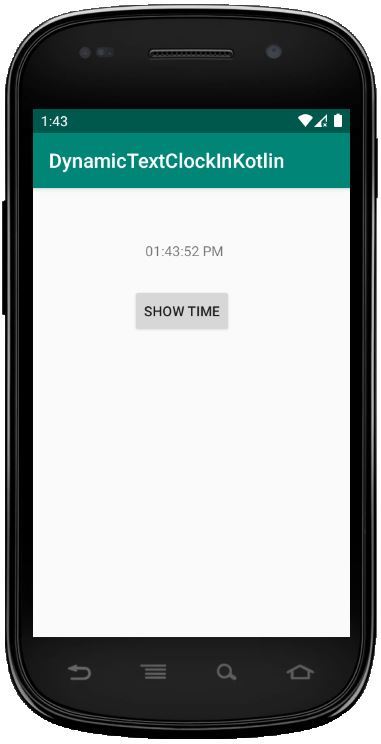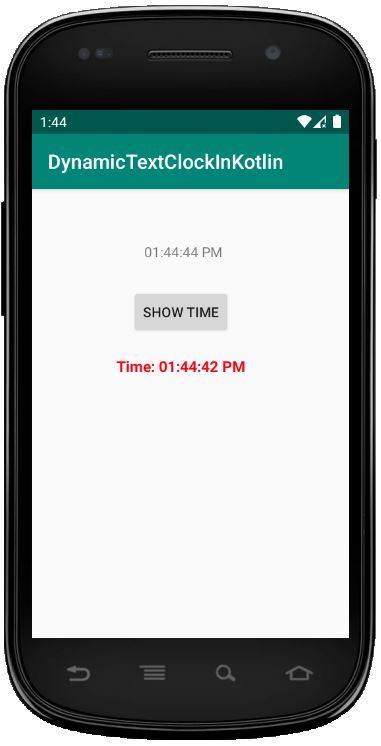Android TextClock es un control de interfaz de usuario que se utiliza para mostrar la fecha/hora en formato de string.
Proporciona la hora en dos modos, el primero es mostrar la hora en formato de 24 horas y el otro es mostrar la hora en formato de 12 horas. Podemos usar fácilmente el método is24HourModeEnabled() para mostrar el sistema usando TextClock en formato de 24 horas o 12 horas.
Aquí, crearemos TextClock mediante programación en el archivo Kotlin.
Primero creamos un nuevo proyecto siguiendo los siguientes pasos:
- Haga clic en Archivo , luego en Nuevo => Nuevo proyecto .
- Después de eso, incluya el soporte de Kotlin y haga clic en siguiente.
- Seleccione el SDK mínimo según su conveniencia y haga clic en el botón siguiente .
- Luego seleccione la actividad vacía => siguiente => finalizar .
Modificar archivo activity_main.xml
En este archivo, usamos TextView y Button y establecemos los atributos de todos los widgets.
XML
<?xml version="1.0" encoding="utf-8"?> <?xml version="1.0" encoding="utf-8"?> <RelativeLayout xmlns:android="http://schemas.android.com/apk/res/android" xmlns:tools="http://schemas.android.com/tools" android:layout_width="wrap_content" android:layout_height="wrap_content" tools:context=".MainActivity"> <LinearLayout xmlns:android="http://schemas.android.com/apk/res/android" android:id="@+id/linear_layout" android:layout_width="wrap_content" android:layout_height="wrap_content" android:gravity="center" android:orientation="vertical" /> <Button android:id="@+id/btn" android:layout_width="wrap_content" android:layout_height="wrap_content" android:layout_marginLeft="100dp" android:layout_marginTop="100dp" android:text="Show Time" /> <TextView android:id="@+id/textview" android:layout_width="wrap_content" android:layout_height="wrap_content" android:layout_below="@+id/btn" android:layout_marginLeft="85dp" android:layout_marginTop="20dp" android:textSize="15dp" android:textStyle="bold" android:textColor="#ff0012"/> </RelativeLayout>
Actualizar el archivo strings.xml
Aquí, actualizamos el nombre de la aplicación usando la etiqueta de string.
XML
<resources> <string name="app_name">DynamicTextClockInKotlin</string> </resources>
Crear TextClock en el archivo MainActivity.kt
Primero, creamos una variable para crear TextClock como este
val textClock = TextClock(this)
luego, establezca el formato de visualización del reloj en el diseño.
textClock.format12Hour = "hh:mm:ss a"
Tenemos que agregar el reloj de texto en el diseño lineal usando
val linearLayout = findViewById(R.id.linear_layout) //add textClock in Linear Layout linearLayout?.addView(textClock)
Kotlin
package com.geeksforgeeks.myfirstkotlinapp
import androidx.appcompat.app.AppCompatActivity
import android.os.Bundle
import android.view.ViewGroup
import android.widget.Button
import android.widget.LinearLayout
import android.widget.TextClock
import android.widget.TextView
class MainActivity : AppCompatActivity() {
override fun onCreate(savedInstanceState: Bundle?) {
super.onCreate(savedInstanceState)
setContentView(R.layout.activity_main)
//create TextClock programmatically
val textClock = TextClock(this)
val layoutParams = LinearLayout.LayoutParams(
ViewGroup.LayoutParams.WRAP_CONTENT,
ViewGroup.LayoutParams.WRAP_CONTENT)
layoutParams.setMargins(140, 80, 80, 80)
textClock.layoutParams = layoutParams
textClock.format12Hour = "hh:mm:ss a"
val linearLayout = findViewById<LinearLayout>(R.id.linear_layout)
//add textClock in Linear Layout
linearLayout?.addView(textClock)
val txtView = findViewById<TextView>(R.id.textview)
val btn = findViewById<Button>(R.id.btn)
// display time when click the button
btn?.setOnClickListener {
txtView?.text = "Time: " + textClock?.text
}
}
}
Archivo AndroidManifest.xml
XML
<?xml version="1.0" encoding="utf-8"?> <manifest xmlns:android="http://schemas.android.com/apk/res/android" package="com.geeksforgeeks.myfirstkotlinapp"> <application android:allowBackup="true" android:icon="@mipmap/ic_launcher" android:label="@string/app_name" android:roundIcon="@mipmap/ic_launcher_round" android:supportsRtl="true" android:theme="@style/AppTheme"> <activity android:name=".MainActivity"> <intent-filter> <action android:name="android.intent.action.MAIN" /> <category android:name="android.intent.category.LAUNCHER" /> </intent-filter> </activity> </application> </manifest>
Ejecutar como emulador:


Publicación traducida automáticamente
Artículo escrito por Praveenruhil y traducido por Barcelona Geeks. The original can be accessed here. Licence: CCBY-SA